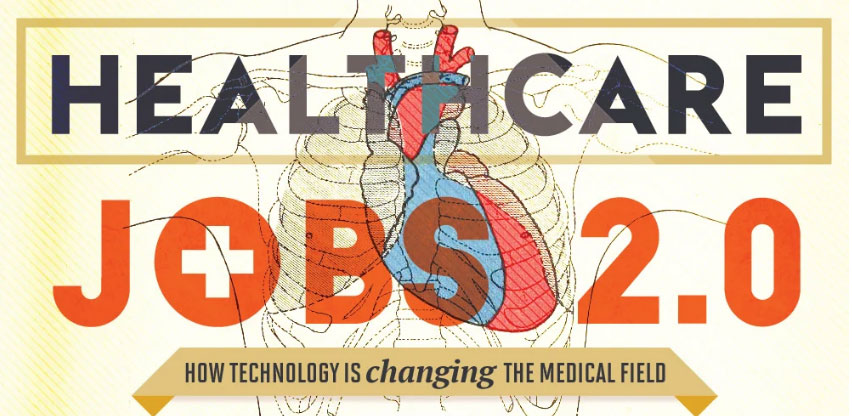Healthcare Jobs 2.0: How Technology is Changing the Medical Field
TABLE OF CONTENTS
I. How Technology is Changing Medical Field Jobs

By 2030, 171 million Americans will have some form of chronic disease, and the U.S. will face a shortage of up to 104,900 physicians.
Healthcare workers will have to find a way to keep up with growing needs, but new technologies are emerging to help.
II. Artificial Intelligence
Developing AI technologies could more quickly and accurately diagnose:
- Strokes caused by blockages in large blood vessels, saving time and brain cells
- Eye diseases such as glaucoma, diabetic retinopathy, and age-related macular degeneration
- Heart disease through interpretation of echocardiograms
- Skin cancer with more accuracy than dermatologists
III. Virtual Healthcare
Virtual visits with doctors, nurses, or other healthcare specialists through communication technology (e.g. video conferencing, messaging, mobile apps):
- Gives patients the option to stay home for check-ups and status updates
- Allows patients to consult out-of-town specialists without having to travel
- Opens up lines of communication leading up to in-person visits
- 53% of people who use health monitors or wearable fitness trackers say they share data with their doctor.
Using virtual healthcare practices for annual patient visits would save:
- 5 minutes per encounter for every U.S. primary care physician
- Equivalent of 37,000 PCPs, or 18% of the workforce
- $7 billion in economic value
Attitudes about virtual care:
- 23% of patients have had a virtual visit with a doctor or nurse
- 57% of those who haven’t had a virtual visit are willing to try it
- Some patients are wary of virtual care, citing a loss of personal connection, concerns about quality of care, and issues with access to technology
- Other patients are optimistic, looking ahead to more convenient hours, ease of use when not feeling well enough to leave home, and eliminating the need to travel away from home or work for healthcare
IV. Nanomedicine
Nanomedicine is the use of nanotechnology and nanodevices to improve medical treatment and diagnosis on an extremely small scale. A nanometer is 1 billionth of a meter; there are 25,400,000 nanometers in an inch.
Smaller drugs and more precise delivery systems will allow doctors to:
- Deliver chemotherapy directly to targeted tumors instead of poisoning an entire body
- Reduce the frequency of drug injections by slowly releasing medicine from a single nanoparticle
Since 1995, 50 nanopharmaceuticals have received FDA approval.
V. Virtual Reality
VR for healthcare worker training:
- In one study, 93% of radiologists who viewed images of arteries through 3D VR technology were more confident when diagnosing splenic artery aneurysms.
- MedStar Health, which operates 10 hospitals in the Baltimore-Washington area, is training healthcare workers by using VR headsets that immerse them in simulated emergency room scenarios.
VR for physical and mental health:
- Pain management: Immersion in virtual worlds has been shown to lower levels of pain and anxiety and have relaxing effects.
- Exposure therapy: VR simulators can recreate frightening or traumatic environments and situations to help mental health patients accept emotions and face fears.
VI. 3D Printing
New printers can create medical tools using any buildable material, from plastic to stem cells:
- Artificial bones for surgical reconstruction
- Custom-tailored prosthetics, ventilated scoliosis braces, supports for amputees
- Tiny organs, or “organoids,” made of layered stem cells that can grow inside the body of a patient and take over when an old organ fails
- The “Polypill:” A 3D-printed pill being developed for patients with multiple illnesses that can hold several drugs at once, each with different release times
VII. Robot-Assisted Surgery
The most commonly used robot-assisted systems are cameras and mechanical arms with attached surgical tools. These arms are controlled by a surgeon through a nearby computer, where he or she sees an HD, magnified view of the surgical site.
Advantages:
- More precise and controlled
- Minimally invasive
- Less risk of complications such as infection
- Less pain and blood loss
- Quicker recovery
- Less noticeable scars
Attitudes toward robot-assisted surgery:
After learning about the benefits, 56% of patients would choose robot-assisted surgery. 18 to 34-year-olds are almost 2x as likely as 45 to 64-year-olds to prefer robot-assisted surgery to traditional surgery.
Technology is revolutionizing medicine from the patient’s home to the operating room一do you know the tools of the trade?
VIII. Sources
- The Growing Crisis of Chronic Disease in the United States | Last accessed April 2024
- Research Shows Shortage of More than 100,000 Doctors by 2030 | Last accessed April 2024
- Artificial intelligence will improve medical treatments | Last accessed April 2024
- Center for Connected Medicine – Top of Mind | Last accessed April 2024
- Virtual Health Care Could Save the U.S. Billions Each Year | Last accessed April 2024
- What Is Nanotechnology? | Last accessed April 2024
- What is Nanomedicine? | Last accessed April 2024
- Progress in Nanomedicine: Approved and Investigational Nanodrugs | Last accessed April 2024
- Stanford study finds VR imaging boosts radiologists’ confidence | Last accessed April 2024
- Healthcare Treatment, Training Reaches New Heights with VR | Last accessed April 2024
- Application of virtual reality technology in clinical medicine | Last accessed April 2024
- Virtual Reality in Medicine and Healthcare to Generate US$285 million in 2022 | Last accessed April 2024
- How 3D printing is revolutionizing healthcare as we know it | Last accessed April 2024
- 3D printing of five-in-one dose combination polypill with defined immediate and sustained release profiles | Last accessed April 2024
- Medical Additive Manufacturing/ 3D Printing Annual Report – 2018 | Last accessed April 2024
- Robotic surgery | Last accessed April 2024
- 2018 Consumer Survey on Digital Health: U.S. Results | Last accessed April 2024

